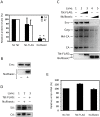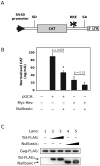Potent inhibition of HIV-1 replication by a Tat mutant
- PMID: 19901984
- PMCID: PMC2768900
- DOI: 10.1371/journal.pone.0007769
Potent inhibition of HIV-1 replication by a Tat mutant
Abstract
Herein we describe a mutant of the two-exon HIV-1 Tat protein, termed Nullbasic, that potently inhibits multiple steps of the HIV-1 replication cycle. Nullbasic was created by replacing the entire arginine-rich basic domain of wild type Tat with glycine/alanine residues. Like similarly mutated one-exon Tat mutants, Nullbasic exhibited transdominant negative effects on Tat-dependent transactivation. However, unlike previously reported mutants, we discovered that Nullbasic also strongly suppressed the expression of unspliced and singly-spliced viral mRNA, an activity likely caused by redistribution and thus functional inhibition of HIV-1 Rev. Furthermore, HIV-1 virion particles produced by cells expressing Nullbasic had severely reduced infectivity, a defect attributable to a reduced ability of the virions to undergo reverse transcription. Combination of these inhibitory effects on transactivation, Rev-dependent mRNA transport and reverse transcription meant that permissive cells constitutively expressing Nullbasic were highly resistant to a spreading infection by HIV-1. Nullbasic and its activities thus provide potential insights into the development of potent antiviral therapeutics that target multiple stages of HIV-1 infection.
Conflict of interest statement
Figures








Similar articles
-
A HIV-1 Tat mutant protein disrupts HIV-1 Rev function by targeting the DEAD-box RNA helicase DDX1.Retrovirology. 2014 Dec 14;11:121. doi: 10.1186/s12977-014-0121-9. Retrovirology. 2014. PMID: 25496916 Free PMC article.
-
A mutant Tat protein provides strong protection from HIV-1 infection in human CD4+ T cells.Hum Gene Ther. 2013 Mar;24(3):270-82. doi: 10.1089/hum.2012.176. Epub 2013 Mar 1. Hum Gene Ther. 2013. PMID: 23298160 Free PMC article.
-
A mutant Tat protein inhibits infection of human cells by strains from diverse HIV-1 subtypes.Virol J. 2017 Mar 14;14(1):52. doi: 10.1186/s12985-017-0705-9. Virol J. 2017. PMID: 28288662 Free PMC article.
-
RNA recognition and regulation of HIV-1 gene expression by viral factor Tat.Biochemistry (Mosc). 1998 May;63(5):489-503. Biochemistry (Mosc). 1998. PMID: 9632883 Review.
-
The role of Tat in HIV-1 replication: an activator and/or a suppressor?AIDS Rev. 2002 Jan-Mar;4(1):41-9. AIDS Rev. 2002. PMID: 11998784 Review.
Cited by
-
Y44A Mutation in the Acidic Domain of HIV-2 Tat Impairs Viral Reverse Transcription and LTR-Transactivation.Int J Mol Sci. 2020 Aug 17;21(16):5907. doi: 10.3390/ijms21165907. Int J Mol Sci. 2020. PMID: 32824587 Free PMC article.
-
Dynamic interactions of the HIV-1 Tat with nucleic acids are critical for Tat activity in reverse transcription.Nucleic Acids Res. 2014 Jan;42(2):1065-78. doi: 10.1093/nar/gkt934. Epub 2013 Oct 22. Nucleic Acids Res. 2014. PMID: 24153111 Free PMC article.
-
Exosome-associated release, uptake, and neurotoxicity of HIV-1 Tat protein.J Neurovirol. 2016 Dec;22(6):774-788. doi: 10.1007/s13365-016-0451-6. Epub 2016 May 12. J Neurovirol. 2016. PMID: 27173397 Free PMC article.
-
Overexpression of PRMT6 does not suppress HIV-1 Tat transactivation in cells naturally lacking PRMT6.Virol J. 2013 Jun 24;10:207. doi: 10.1186/1743-422X-10-207. Virol J. 2013. PMID: 23800116 Free PMC article.
-
Differential Effects of Strategies to Improve the Transduction Efficiency of Lentiviral Vector that Conveys an Anti-HIV Protein, Nullbasic, in Human T Cells.Virol Sin. 2018 Apr;33(2):142-152. doi: 10.1007/s12250-018-0004-7. Epub 2018 Mar 14. Virol Sin. 2018. PMID: 29541943 Free PMC article.
References
-
- Dayton AI, Sodroski JG, Rosen CA, Goh WC, Haseltine WA. The trans-activator gene of the human T cell lymphotropic virus type III is required for replication. Cell. 1986;44:941–947. - PubMed
-
- Berkhout B, Silverman RH, Jeang KT. Tat trans-activates the human immunodeficiency virus through a nascent RNA target. Cell. 1989;59:273–282. - PubMed
Publication types
MeSH terms
Substances
LinkOut - more resources
Full Text Sources
Other Literature Sources

